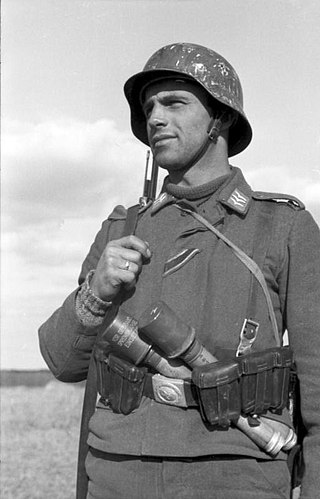Top Qs
Timeline
Chat
Perspective
Luftwaffe Field Divisions
Ground forces of the ''Luftwaffe'' From Wikipedia, the free encyclopedia
Remove ads
The Luftwaffe field divisions (German: Luftwaffen-Feld-Divisionen) were the ground forces of the German Luftwaffe during World War II.

History
Summarize
Perspective
The divisions were originally authorized in October 1942, following suggestions that the German Army (Heer) could be bolstered by transferring personnel from other services. The head of the Luftwaffe, Hermann Göring, formulated an alternative plan to raise his own infantry formations under the command of Luftwaffe officers; this was at least partly due to political differences with the Army. Göring took great pride in the degree of political commitment and indoctrination of Luftwaffe personnel; he described paratroopers of the Luftwaffe as "political soldiers". The Army was considered by Nazi standards too "conservative" – linked to conservative or monarchical traditions and ideals harking back to the Imperial days of the Kaiser.

The plan was approved, and the divisions were raised from 200,000–250,000 Luftwaffe ground, support, and other excess personnel. They were initially organized with two Jäger (light infantry) regiments of three battalions each, along with an artillery battalion and other support units, but were substantially smaller than equivalent Army divisions, and by Göring's personal order were intended to be restricted to defensive duties in quieter sectors.
Most of the units spent much of their existence on the Eastern Front. Luftwaffe Field Divisions were present at actions such as the "Little Stalingrad of the North", the attempt to relieve Velikiye Luki in November 1942–January 1943; Battle of Nevel, they were at the Oranienbaum Bridgehead at Leningrad, & the withdrawal to the Kuban Bridgehead. They were part of Manstein's Army Group Don as it attempted to defend against Operation Little Saturn & the attempted defence of Vitebsk during Operation Bagration in June 1944, and the fighting in the Courland Pocket from July 1944 to May 1945, though they also fought in other theatres.
The Luftwaffe Field Divisions initially remained under Luftwaffe command, but late in 1943 those that had not already been disbanded were handed over to the Army and were reorganized as standard infantry divisions with three two-battalion rifle regiments. They retained their numbering, but with Luftwaffe attached to distinguish them from similarly numbered divisions already existing in the Army and had Army officers.
Until taken over by the Army, and in many cases for some time afterwards, these units were issued with standard Luftwaffe feldblau ("field blue") uniforms, and being so easily identifiable were said to often be singled out by opposing forces. Their reputation as combat troops was poor, despite the high standard of Luftwaffe recruits, at least in part because they were required to perform roles for which they as airmen usually had little training. An exception to the poor combat performance of Luftwaffe ground troops were Fallschirmjäger (paratrooper) units, whose performance was generally good, due to higher motivation, better training and higher entrance standards when compared to the Luftwaffe Field Divisions. Early Fallschirmjäger troops were also transferred directly from the Army to the Luftwaffe. Luftwaffe Field Division airmen were frequently used for rear-echelon duties to free up front-line troops.[1][2][3]
Remove ads
List of Luftwaffe Field Divisions

Remove ads
Luftwaffe Field Corps
- I Luftwaffe Field Corps, planned during the winter of 1942–1943 on the basis of the 13th Air Corps (German: XIII. Fliegerkorps), but never really established.
- II Luftwaffe Field Corps, October 1942–1 November 1943: 2nd, 3rd, 4th, and 6th Luftwaffe Field Divisions (Alfred Schlemm)[20]
- III Luftwaffe Field Corps, January 1943–November 1943: 9th and 10th Luftwaffe Field Division (Job Odebrecht)[21]
- IV Luftwaffe Field Corps, January 1943–19 November 1944: 189th and 198th Infantry Divisions (Army) and 716th Static Infantry Division (Army) (Erich Petersen)[22]
See also
- 1st Fallschirm-Panzer Division Hermann Göring
- Fallschirm-Panzergrenadier Division 2 Hermann Göring
- List of German divisions in World War II
- Motor Rifle Regiment of the Aerospace Forces, similar unit during the Russian invasion of Ukraine
References
External links
Wikiwand - on
Seamless Wikipedia browsing. On steroids.
Remove ads
